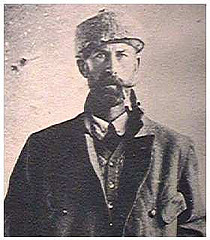
There’s no chalice on the table in Leonardo’s Last Supper …
… but there is one on Bartholemew’s head (far left).

There’s no chalice on the table in Leonardo’s Last Supper …
… but there is one on Bartholemew’s head (far left).
May 30, 1811. The workmen, on removing the rubbish of part of the cliff, near Dover Castle, that fell down a few months before, by which a mother and her children were killed, and their bodies found the next day, discovered a hog that was buried in the ruins at the same time, and was supposed to have perished; but, strange as it may appear, he was found alive, making it exactly five months and nine days since the accident. At that time the animal weighed about seven score; when he was found, he was wasted to about 30 pounds; but is still likely to do well.
— National Register, June 2, 1811
Monkeys in India are more or less objects of superstitious reverence, and are, consequently, seldom or ever destroyed. In some places they are even fed, encouraged, and allowed to live on the roofs of the houses. If a man wish to revenge himself for any injury committed upon him, he has only to sprinkle some rice or corn upon the top of his enemy’s house, or granary, just before the rains set in, and the monkeys will assemble upon it, eat all they can find outside, and then pull off the tiles to get at that which falls through the crevices. This, of course, gives access to the torrents which fall in such countries, and house, furniture, and stores are all ruined.
— Edmund Fillingham King, Ten Thousand Wonderful Things, 1860
In June 1911, a meteorite fell to earth in Alexandria, Egypt. A local farmer named Mohammed Ali Effendi Hakim claimed that one fragment had landed on his dog. If it’s true, this would be the first recorded instance of a meteorite killing an animal. But it’s hard to verify without evidence — the dog, if it ever existed, was vaporized.

An enterprising rhinoceros could make a pretty good living in 18th-century Europe, where people clamored to see such an outlandish creature. A rhino named Clara toured the continent for 17 years in a special wooden carriage, meeting royalty in England, France, Prussia and Poland and posing for portraits and sculptures. The French navy even named a ship after her.
She died in 1758, probably wondering what all the fuss was about.
August 18, 1765. One Carr, a waterman, having laid a wager, that he and his dog would leap from the centre arch of Westminster Bridge, and land at Lambeth, within a minute of each other; he jumped off first, and the dog immediately followed him; but the faithful animal not being in the secret, and fearing his master should be drowned, laid hold of him by the neck, and dragged him to the shore, to the no small diversion of the spectators.
— Annual Register, 1765

Percy Fawcett set out to solve a mystery and only compounded it. In 1925, after studying ancient legends, the British archaeologist became convinced that the dense Matto Grosso region of western Brazil concealed a lost city that he called “Z.” In May he set out with two other men into the uncharted jungle, leaving a note that none should try to rescue them if they did not return.
They didn’t. The decades that followed brought many rumors: Fawcett had been murdered by Indians, killed by a wild animal, stricken with amnesia or felled by illness. In all, 100 rescuers in 13 expeditions have died trying to discover what happened to him. To this day, no one knows.
Mr. James Wrigley, master of the Golden Lion inn, at Liverpool, going into his cellar, October 26, 1759, having some oysters there, a large Norway rat, endeavouring to seize an oyster that was open, it closed, and held him so fast, that he was carried into the kitchen, and exhibited to some hundred persons, while alive.
— Annual Register, 1759
Cricketer I.L. Bula played nine first-class matches for Fiji between 1947 and 1954.
Sportswriters must have been glad he didn’t use his full name — it was Ilikena Lasarusa Talebulamainavaleniveivakabulaimainakulalakebalau.
Daniel McCartney never needed a diary — he could remember every day of his life since age 9. On his death in 1887, the Cardington, Ohio, Independent published this account:
That the reader may more clearly understand what has just been written, I will give Mr. McCartney’s answer to a question of my own: ‘Wife and I were married on the 28th day of January, 1836; give the day of the week, the kind of weather, etc.?’ He gave answer in a few seconds. ‘You were married on Thursday, there was snow on the ground, good sleighing and not very cold; father and I were hauling hay; a sole came off the sled, we had to throw the hay off, put a new sole on the sled and load up again before we could go.’
The writer (whose name is not given) met McCartney again a dozen years later and asked the same question. McCartney gave the same details.